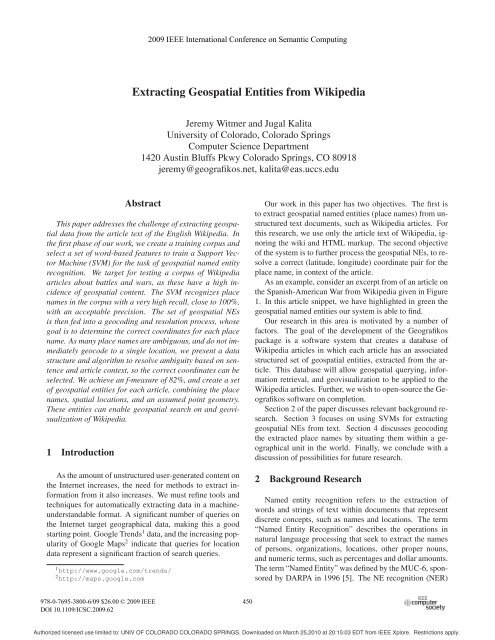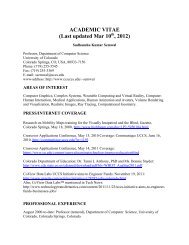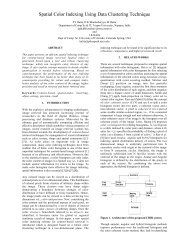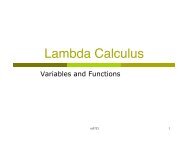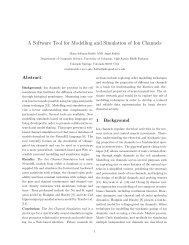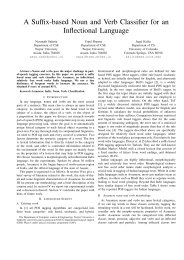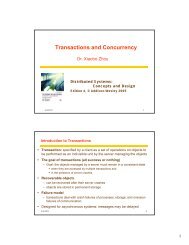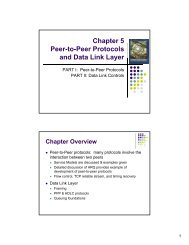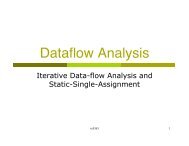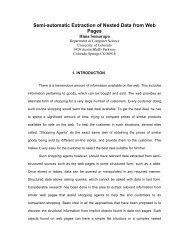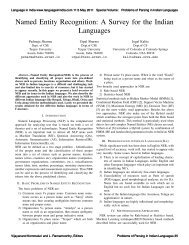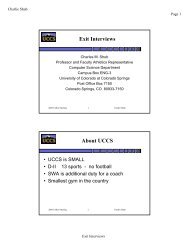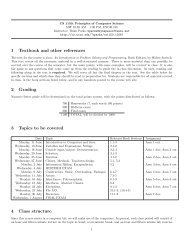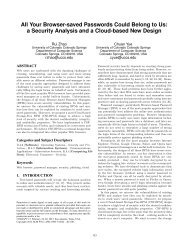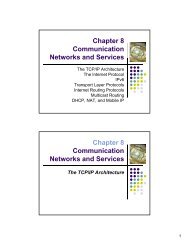Extracting Geospatial Entities from Wikipedia - ResearchGate
Extracting Geospatial Entities from Wikipedia - ResearchGate
Extracting Geospatial Entities from Wikipedia - ResearchGate
Create successful ePaper yourself
Turn your PDF publications into a flip-book with our unique Google optimized e-Paper software.
2009 IEEE International Conference on Semantic Computing<br />
<strong>Extracting</strong> <strong>Geospatial</strong> <strong>Entities</strong> <strong>from</strong> <strong>Wikipedia</strong><br />
Jeremy Witmer and Jugal Kalita<br />
University of Colorado, Colorado Springs<br />
Computer Science Department<br />
1420 Austin Bluffs Pkwy Colorado Springs, CO 80918<br />
jeremy@geografikos.net, kalita@eas.uccs.edu<br />
Abstract<br />
This paper addresses the challenge of extracting geospatial<br />
data <strong>from</strong> the article text of the English <strong>Wikipedia</strong>. In<br />
the first phase of our work, we create a training corpus and<br />
select a set of word-based features to train a Support Vector<br />
Machine (SVM) for the task of geospatial named entity<br />
recognition. We target for testing a corpus of <strong>Wikipedia</strong><br />
articles about battles and wars, as these have a high incidence<br />
of geospatial content. The SVM recognizes place<br />
names in the corpus with a very high recall, close to 100%,<br />
with an acceptable precision. The set of geospatial NEs<br />
is then fed into a geocoding and resolution process, whose<br />
goal is to determine the correct coordinates for each place<br />
name. As many place names are ambiguous, and do not immediately<br />
geocode to a single location, we present a data<br />
structure and algorithm to resolve ambiguity based on sentence<br />
and article context, so the correct coordinates can be<br />
selected. We achieve an f-measure of 82%, and create a set<br />
of geospatial entities for each article, combining the place<br />
names, spatial locations, and an assumed point geometry.<br />
These entities can enable geospatial search on and geovisualization<br />
of <strong>Wikipedia</strong>.<br />
1 Introduction<br />
As the amount of unstructured user-generated content on<br />
the Internet increases, the need for methods to extract information<br />
<strong>from</strong> it also increases. We must refine tools and<br />
techniques for automatically extracting data in a machineunderstandable<br />
format. A significant number of queries on<br />
the Internet target geographical data, making this a good<br />
starting point. Google Trends 1 data, and the increasing popularity<br />
of Google Maps 2 indicate that queries for location<br />
data represent a significant fraction of search queries.<br />
1 http://www.google.com/trends/<br />
2 http://maps.google.com<br />
Our work in this paper has two objectives. The first is<br />
to extract geospatial named entities (place names) <strong>from</strong> unstructured<br />
text documents, such as <strong>Wikipedia</strong> articles. For<br />
this research, we use only the article text of <strong>Wikipedia</strong>, ignoring<br />
the wiki and HTML markup. The second objective<br />
of the system is to further process the geospatial NEs, to resolve<br />
a correct (latitude, longitude) coordinate pair for the<br />
place name, in context of the article.<br />
As an example, consider an excerpt <strong>from</strong> of an article on<br />
the Spanish-American War <strong>from</strong> <strong>Wikipedia</strong> given in Figure<br />
1. In this article snippet, we have highlighted in green the<br />
geospatial named entities our system is able to find.<br />
Our research in this area is motivated by a number of<br />
factors. The goal of the development of the Geografikos<br />
package is a software system that creates a database of<br />
<strong>Wikipedia</strong> articles in which each article has an associated<br />
structured set of geospatial entities, extracted <strong>from</strong> the article.<br />
This database will allow geospatial querying, information<br />
retrieval, and geovisualization to be applied to the<br />
<strong>Wikipedia</strong> articles. Further, we wish to open-source the Geografikos<br />
software on completion.<br />
Section 2 of the paper discusses relevant background research.<br />
Section 3 focuses on using SVMs for extracting<br />
geospatial NEs <strong>from</strong> text. Section 4 discusses geocoding<br />
the extracted place names by situating them within a geographical<br />
unit in the world. Finally, we conclude with a<br />
discussion of possibilities for future research.<br />
2 Background Research<br />
Named entity recognition refers to the extraction of<br />
words and strings of text within documents that represent<br />
discrete concepts, such as names and locations. The term<br />
“Named Entity Recognition” describes the operations in<br />
natural language processing that seek to extract the names<br />
of persons, organizations, locations, other proper nouns,<br />
and numeric terms, such as percentages and dollar amounts.<br />
The term “Named Entity” was defined by the MUC-6, sponsored<br />
by DARPA in 1996 [5]. The NE recognition (NER)<br />
9780769538006/09 $26.00 © 2009 IEEE<br />
DOI 10.1109/ICSC.2009.62<br />
450<br />
Authorized licensed use limited to: UNIV OF COLORADO COLORADO SPRINGS. Downloaded on March 25,2010 at 20:15:03 EDT <strong>from</strong> IEEE Xplore. Restrictions apply.
Figure 1. Example <strong>Wikipedia</strong> Article with <strong>Geospatial</strong> NEs Highlighted<br />
task was further defined, and expanded to language independence<br />
by the Conference on Natural Language Learning<br />
shared task for the 2002 and 2003 conferences.<br />
Numerous approaches have been tried since MUC-6 to<br />
increase performance in NER, including Hidden Markov<br />
Models, Conditional Random Fields, Maximum Entropy<br />
models, Neural Networks, and Support Vector Machines<br />
(SVM).<br />
SVMs [14] are a subset of kernel-based methods used<br />
for regression and classification. An SVM views input data<br />
as feature vectors in N-dimensional space, with the goal of<br />
finding an optimal hyperplane that separates the vectors into<br />
positive and negative classes, based on a function learned<br />
<strong>from</strong> a set of training vectors. Theoretical and experimental<br />
results indicate that SVMs are able to generalize very well<br />
and avoid overfitting in high dimensional feature spaces.<br />
SVMs have shown significant promise for the task of<br />
NER. Starting with the CoNLL 2002 shared task on NER,<br />
SVMs have been applied to this problem domain with improving<br />
performance. Bhole et al. have done significant<br />
work in extracting named entities <strong>from</strong> <strong>Wikipedia</strong> and relating<br />
them over time using SVMs [1]. In the biomedical<br />
domain, Takeuchi and Collier have demonstrated that<br />
SVMs outperform HMMs for NER [13]. Furthermore, Lee<br />
et al. [8] and Habib [6] have shown that SVMs are applicable<br />
to multi-class NER and text classification problems.<br />
Isozaki and Kazawa provide results in [7] showing<br />
that chunking and part-of-speech tagging also provide performance<br />
increases for NER with SVMs, both in speed and<br />
in f-measure. In [3], Dakka and Cucerzan demonstrate an<br />
SVM that achieves an f-measure of 0.954 for LOC entities<br />
in <strong>Wikipedia</strong> articles, and an f-measure of 0.884 across all<br />
NE classes. Using an SVM in conjunction with a fuzzy<br />
SVM which allows greater margin overlap in the cost parameter,<br />
Mansouri et al. demonstrate excellent performance<br />
on NER [9]. Thus, research into text classification and NER<br />
has found that SVMs provide good performance on NER<br />
tasks, despite the inherent difficulties in NER.<br />
3. <strong>Geospatial</strong> Named Entity Extraction<br />
Our first task is to extract all candidate geospatial NEs.<br />
The desired output of this stage of the Geografikos package<br />
is a set of words and strings that may be place names.<br />
Below, we discuss the selection of the feature set used to<br />
to train the SVM, the generation of the training and testing<br />
corpuses, the preprocessing of the text, and finally, the<br />
results. In this initial NE recognition task we target high<br />
recall, even with a sacrifice in precision, as this means that<br />
we extracted all of the possible candidate NE strings.<br />
3.1. Training Corpus Generation<br />
We downloaded a number of previously tagged data sets<br />
to provide the training material for the SVM, along with<br />
other resources that required hand-tagging:<br />
• Spell Checker-Oriented Word List (SCOWL) 3 to provide<br />
a list of English words.<br />
• CoNLL 2003 shared task dataset on multi-language<br />
NE tagging 4 containsing tagged named entities for<br />
PER, LOC, and ORG, in English.<br />
3 http://downloads.sourceforge.net/wordlist/<br />
scowl-6.tar.gz<br />
4 http://www.cnts.ua.ac.be/conll2003/ner/<br />
451<br />
Authorized licensed use limited to: UNIV OF COLORADO COLORADO SPRINGS. Downloaded on March 25,2010 at 20:15:03 EDT <strong>from</strong> IEEE Xplore. Restrictions apply.
• Reuters Corpus <strong>from</strong> NIST: 5 15,000 selected words<br />
<strong>from</strong> the corpus were hand-tagged for LOC entities.<br />
• CoNLL 2004 shared task dataset, on Semantic Role<br />
Labeling 6 tagged for English LOC NEs.<br />
• CoNLL 2005 shared task dataset, on Semantic Role<br />
Labeling 7 tagged for English LOC NEs.<br />
• Geonames database of 6.2 million names of cities,<br />
counties, countries, land features, rivers and lakes. 8<br />
To generate the training corpus, we combined our handtagged<br />
Reuters corpus and the three CoNLL datasets. We<br />
extracted those records in the 2.5 million word Geonames<br />
database in either the P or A Geonames codes (Administrative<br />
division and Population center), which provided<br />
the names of cities, villages, countries, states, and regions.<br />
Combined with SCOWL wordlist, which provided negative<br />
examples, this resulted in a training set of 1.2 million unique<br />
words.<br />
3.2. Testing Corpus Generation<br />
To generate the test corpus, we selected 90 articles <strong>from</strong><br />
<strong>Wikipedia</strong> on battles and wars around the world. Before the<br />
text of each of the articles was tagged, the actual text returned<br />
<strong>from</strong> the database required preprocessing to remove<br />
the <strong>Wikipedia</strong>-specific markup, HTML, and other extraneous<br />
information. Preprocessing was in five steps.<br />
First, extraneous sections such as “References”, “See<br />
Also”, or “Notes” were removed. These sections do not<br />
contribute any information to the primary text. Second,<br />
all HTML markup was stripped. While most markup in<br />
<strong>Wikipedia</strong> is done in wiki style, some markup in the pages<br />
is still done in HTML.<br />
Third, the <strong>Wikipedia</strong> infoboxes in the page were processed.<br />
Infoboxes are special constructs that reference external<br />
blocks of text. A certain number of these infoboxes<br />
are system infoboxes conveying information for processing<br />
and display which were removed completely. However, if<br />
the infobox contributed to the primary text of the page, one<br />
of two operations were performed. In a small set of cases,<br />
the infoboxes were links to another full article page. These<br />
infoboxes were replaced with a <strong>Wikipedia</strong> link to the other<br />
page. For all the other infoboxes, the full text of the infobox<br />
was inserted into the primary text. Because infoboxes can<br />
also contain infoboxes, this processing was recursive.<br />
Fourth, for <strong>Wikipedia</strong>-style links, the link text was removed,<br />
and replaced with either the name of linked page<br />
or with the caption text for links with a caption. Finally,<br />
5 http://trec.nist.gov/data/reuters/reuters.html<br />
6 http://www.lsi.upc.es/˜srlconll/st04/st04.html<br />
7 http://www.lsi.upc.es/˜srlconll/soft.html<br />
8 http://www.geonames.org/export/<br />
cleanup was done for any remaining link or infobox symbols.<br />
Links to external sites were removed. Special characters,<br />
unicode and special symbols were removed, as these<br />
did not add any information, and tended to cause exceptions<br />
and problems in string processing.<br />
The cleaned primary text of each page was split into an<br />
array of individual words, and the individual words were<br />
hand-tagged as geospatial NEs or not, either 1 or 0.<br />
3.3. SVM Feature Selection<br />
To define the features describing the geospatial NEs, we<br />
drew primarily <strong>from</strong> the work done for word-based feature<br />
selection by Habib [6]. She used lexical, word-shape, and<br />
other language-independent features to train an SVM for the<br />
extraction of NEs in the biomedical domain. Furthermore,<br />
the work done by Cucerzan et al. [2] on extracting NEs<br />
<strong>from</strong> <strong>Wikipedia</strong> provided further features.<br />
For feature set selection, we postulated that each word in<br />
the geospatial NE should be independent, and that the training<br />
corpus should be split into individual words. After testing<br />
various combinations of features, we used the following<br />
features for each word to generate the feature vectors for the<br />
SVM, with equal weighting on all features:<br />
• Word length: alphanumeric character count, ignoring<br />
punctuation marks<br />
• Vowel count, consonant count, and capital count in the<br />
word<br />
• First capital: if the word begins with a capital letter<br />
• If the word contains two vowels together<br />
• If the word contains two identical consonants together<br />
• If the word ends with a comma, a period, a hyphen, a<br />
semi-colon, or a colon<br />
• If the word begins or ends with a quote<br />
• If the word begins or ends with a parenthesis<br />
• If the word is plural, or a single character<br />
• If the word is alphanumeric, purely numeric, purely<br />
text, all uppercase, or all lowercase<br />
• If the word has an English suffix or prefix<br />
• If the word is a preposition, an article, a pronoun, a<br />
conjunction, an interrogative or an auxiliary verb<br />
3.4. SVM Training and Results<br />
We used LibSVM to train an SVM based on the feature<br />
vectors and two parameters, C and γ, which are the cost<br />
and degree coefficient of the SVM kernel function. Lib-<br />
SVM provides a Python script to perform a step-wise grid<br />
search for the optimal C and γ values, finding local maxima<br />
in the fitness graph, and randomly jumping to a new (C, γ)<br />
starting point to try to find the overall maximum. After using<br />
the grid search, the optimal parameters were determined<br />
to be C =8and γ =0.03125.<br />
452<br />
Authorized licensed use limited to: UNIV OF COLORADO COLORADO SPRINGS. Downloaded on March 25,2010 at 20:15:03 EDT <strong>from</strong> IEEE Xplore. Restrictions apply.
Table 1. Training Corpus Combination Results<br />
for the NER SVM<br />
Corpus Precision Recall F<br />
R 0.38 0.63 0.47<br />
R + C03 + C04 + C05 0.45 0.68 0.54<br />
R + C03 + C04 + C05 + 0.49 0.75 0.59<br />
SCW<br />
Wiki 0.65 0.34 0.44<br />
Wiki + R + C03 + C04 + 0.60 0.55 0.57<br />
C05 + SCW<br />
Geo + R + C03 + C04 + TC TC TC<br />
C05 + SCW<br />
FGeo + R + C03 + C04 + 0.51 0.99 0.67<br />
C05 + SCW<br />
R: Reuters Corpus. C03: CoNLL 2003 dataset. C04:<br />
CoNLL 2004 dataset. C05: CoNLL 2005 dataset. Wiki:<br />
<strong>Wikipedia</strong> data. SCW: SCOWL wordlist. Geo: full<br />
Geonames database. FGeo: Filtered Geonames database.<br />
TC: Training Canceled.<br />
We selected a radial basis function kernel, and applied it<br />
to the C-SVC, the standard cost-based SVM classifier. The<br />
SVM was trained using feature vectors based on the second<br />
training corpus, requiring 36 hours to complete. This<br />
trained SVM was used throughout the rest of this work.<br />
Our goal was to obtain high recall while maintaining<br />
good precision. Table 1 shows the precision, recall, and f-<br />
measure numbers for training corpuses created with different<br />
subsets of the training data. The performance numbers<br />
are the results <strong>from</strong> the <strong>Wikipedia</strong> testing corpus.<br />
The recall <strong>from</strong> the SVM increased significantly when<br />
we introduced the Geonames database as part of the training<br />
corpus, but the full Geonames database, some 2.5 million<br />
words, significantly impacted the SVM, and we were unable<br />
to complete training on an SVM, after 5 days. In part,<br />
this was because the training set is large, but we also found<br />
that there were many occurrences of words marked both as<br />
positive and negative examples of geospatial NEs. We then<br />
filtered the Geonames database to the final set, using only<br />
administrative division and population center names, which<br />
brought the precision back up to acceptable levels.<br />
After selecting the optimal training corpus, we optimized<br />
the feature set for the SVM. Table 2 shows a breakdown of<br />
the feature sets we tested separately. We found that the list<br />
presented earlier provided the best performance by close to<br />
10% in f-measure over any other combination of features.<br />
After selecting the final set of features, we performed<br />
some initial experiments in weighting the features differently.<br />
We found that in all cases, changing the weighting<br />
on the features resulted in an f-measure loss between<br />
0.21% and 3.4%, not a significant impact on the perfor-<br />
Table 2. Feature Set Combination Results for<br />
the NER SVM<br />
Feature Set<br />
SHP+PUN+HYP+SEP 0.44<br />
SHP+CAP+PUN+HYP+SEP 0.47<br />
CAP+VOW+CON 0.51<br />
SHP+CAP 0.54<br />
SHP+CAP+VOW+CON 0.56<br />
SHP+CAP+VOW+CON+AFF+POS 0.58<br />
SHP+CAP+VOW+CON+PUN<br />
+HYP+SEP+AFF+ POS 0.67<br />
F-Measure<br />
SHP: Word shape, including length and alphanumeric<br />
content. CAP: Capital positions and counts. VOW: Vowel<br />
positions and counts. CON: Consonant positions and<br />
counts. PUN: Punctuation. HYP: Hyphens. SEP:<br />
Separators, quotes, parenthesis, etc. AFF: Affixes. POS:<br />
part of speech categorization.<br />
mance. We concluded that, we did not need to spend a significant<br />
amount of time on working with the feature weighting,<br />
and simply weighted all features equally at 1.0.<br />
Once we found the optimal feature set for the SVM, we<br />
re-trained and tested the SVM with other corpus combinations.<br />
However, the results of the original corpus selection<br />
remained the best.<br />
With this setup, we were successful in training the SVM<br />
to return high recall numbers, recognizing 99.8% of the<br />
geospatial named entities. Unfortunately, this was at the<br />
cost of precision. The SVM returned noisy results with only<br />
51.0% precision, but the noise was processed out during the<br />
NE geocoding process, to obtain our final results, discussed<br />
in the next section.<br />
4. <strong>Geospatial</strong> Named Entity Resolution<br />
The SVM extracted a set of candidate geospatial NEs<br />
<strong>from</strong> the article text. For each candidate string, the second<br />
objective was to decide whether it was a geospatial NE, and<br />
to determine the correct (latitude, longitude), or (φ, λ) coordinate<br />
pair for the place name in context of the article.<br />
To resolve the candidate NE, a lookup was made using<br />
Google Geocoder 9 . If the entity reference resolved to a single<br />
geospatial location, no further action was required. Otherwise,<br />
the context of the place name in the article, a new<br />
data structure and a rule-driven algorithm were used to decide<br />
the correct spatial location for the place name.<br />
Our research targeted the so-called context locations, defined<br />
as “the geographic location that the content of a web<br />
9 http://code.google.com/apis/maps/<br />
documentation/geocoding/index.html<br />
453<br />
Authorized licensed use limited to: UNIV OF COLORADO COLORADO SPRINGS. Downloaded on March 25,2010 at 20:15:03 EDT <strong>from</strong> IEEE Xplore. Restrictions apply.
Table 3. Places With Multiple Names and<br />
Names Applied to More Than One Place in the<br />
Getty Thesaurus of Geographic Names<br />
Continent % places<br />
with multiple<br />
names<br />
North & Central 11.5 57.1<br />
America<br />
Oceania 6.9 29.2<br />
South America 11.6 25.0<br />
Asia 32.7 20.3<br />
Africa 27.0 18.2<br />
Europe 18.2 16.6<br />
% names<br />
with multiple<br />
places<br />
resource describes” [16]. Our task is close to that of word<br />
sense disambiguation, as defined by Cucerzan [2], only that<br />
we consider the geospatial context and domain instead of<br />
the lexical context and domain. Sehgal et al. demonstrate<br />
good results for geospatial entity resolution using both spatial<br />
(coordinate) and non-spatial (lexical) features of the<br />
geospatial entities [11]. Zong et al. demonstrate a rulebased<br />
method for place name assignment, achieving a precision<br />
of 88.6% on disambiguating place names in the United<br />
States, <strong>from</strong> the Digital Library for Earth System Education<br />
(DLESE) metadata [18].<br />
While related to the work done by Martins et al. in [10],<br />
we apply an SVM for the initial NER task, and only use<br />
the geocoder/gazetter for lookups after the initial candidate<br />
geospatial NEs have been identified. We also draw on our<br />
earlier work in this area, covered in [17]<br />
The primary challenge to the resolution and disambiguation<br />
is that multiple names can refer to the same place, and<br />
multiple places can have the same name. The statistics for<br />
these place name and reference overlap are given in Table<br />
3, <strong>from</strong> [12]. The table demonstrates that the largest area<br />
with ambiguous place names is North and Central America,<br />
the prime areas for our research. Most of the name overlaps<br />
are in city names, and not in state/province names. These<br />
statistics are further supported by the location name breakdowns<br />
on the individual <strong>Wikipedia</strong> articles in Table 4. The<br />
details in this table are broken down into countries, states,<br />
foreign cities, foreign features, US cities, and US features,<br />
where “features” are any non-state or city geospatial features,<br />
such as rivers, hills, and ridges. The performance of<br />
the Geografikos system on NER extraction and disambiguation<br />
is indicated. The Battle of Gettysburg, with over 50%<br />
US city names, many of which overlap, resulted in the lowest<br />
performance. The Liberty Incident, in the Mediterranean<br />
Sea, with less than 10% US city and state names combined,<br />
showed significantly better performance.<br />
4.1. Google Geocoder<br />
We used Google Geocoder as the gazetteer and geocoder<br />
for simplicity, as much research has already been done in<br />
this area. Vestavik and D’Roza et al provide an excellent<br />
overview of existing technology in this area [15, 4]. Google<br />
Geocoder provides a simple REST-based interface that can<br />
be queried over HTTP, returning data in a variety of formats.<br />
For each geospatial NE string submitted as a query,<br />
Google Geocoder returns 0 or more placemarks as a result.<br />
Each placemark corresponds to a single (φ, λ) coordinate<br />
pair. If the address string is unknown, or another error occurs,<br />
the geocoder returns no placemarks. If the query resolves<br />
to a single location, Google Geocoder returns a single<br />
placemark. If the query string is ambiguous, it may return<br />
more than one placemarks. A country code can also be<br />
passed as part of the request parameters to bias the geocoder<br />
toward a specific country. Google Geocoder returns locations<br />
at roughly four different levels, Country, State, City,<br />
and Street/Feature, depending on the address query string<br />
and the area of the world.<br />
In the Geografikos package, the address string returned<br />
<strong>from</strong> Google Geocoder was separated into the four parts,<br />
and each part was stored separately, with the coordinates.<br />
The coordinates were also checked against the existing set<br />
of locations in the database for uniqueness. For this research,<br />
coordinates had to be more than 1/10th of a mile<br />
apart to be considered a unique location.<br />
4.2. Location Tree Data Structure<br />
The output <strong>from</strong> the Google Geocoder was fed thorough<br />
our location tree data structure, which, along with an algorithm<br />
driven by a simple set of rules, ordered the locations<br />
by geospatial division, and aided in the disambiguation of<br />
any ambiguous place name.<br />
The location tree operated at four levels of hiearchy,<br />
Country, State/Province, City, and Street/Local Geographic<br />
Feature. Each placemark response <strong>from</strong> the geocoder corresponded<br />
to one of these geospatial divisions. A separate<br />
set of rules governed the insertion of a location at each level<br />
of the tree. For simple additions to the tree, the rules were:<br />
1. If the location is a country, add it to the tree<br />
2. If the location is a state or province, add it to the tree<br />
3. If the location is a city in the US, and the parent node<br />
in the tree is a state, add it to the tree<br />
4. If the location is a city outside the US, add it to the tree<br />
5. If the location is a street or feature inside the US, and<br />
the parent node is a state or city, add it to the tree<br />
6. If the location is a street or outside the US, and the<br />
parent node is either a country or city, add it to the tree<br />
454<br />
Authorized licensed use limited to: UNIV OF COLORADO COLORADO SPRINGS. Downloaded on March 25,2010 at 20:15:03 EDT <strong>from</strong> IEEE Xplore. Restrictions apply.
Table 4. Place Name Details for Example <strong>Wikipedia</strong> Articles. All numbers are percentages.<br />
Article name Foreign features US Features Foreign Cities US Cities States Countries F-measure<br />
Battle of Gettysburg 0 31 1 51 15 2 68.2<br />
War of 1812 3 18 5 30 8 36 81.6<br />
World War II 20 0 17 1 0 62 87.0<br />
Liberty Incident 25 1 10 6 1 57 90.5<br />
Rules 3 and 5 are US-specific because Google Geocoder<br />
has much more detailed place information for the US than<br />
other areas of the world, requiring extra processing.<br />
Any location that did not match any rule was placed on<br />
a pending list. Each time a new location was added, the<br />
tree was re-sorted to ensure that the correct hierarchy was<br />
maintained, and each location on the pending list was rechecked<br />
to see if it now matched the rules for insertion.<br />
If the location returned <strong>from</strong> Google Geocoder had a single<br />
placemark and matched the rules, it was placed in the<br />
tree. If the location returned corresponded to multiple coordinates,<br />
another set of calculations was required before running<br />
insertion rule set. First, any ambiguous locations were<br />
placed on the pending list until all other locations were processed.<br />
This ensured that we have the most complete context<br />
possible, and that all non-ambiguous locations were in<br />
the tree before the ambiguous locations were processed.<br />
Once we finished processing all the non-ambiguous locations<br />
in the candidate list, we had a location tree, and a<br />
set of pending locations, some of which could fit more than<br />
one place on the tree. As each node is inserted into the<br />
tree, a running count of nodes and repeated nodes are kept.<br />
Using this information, when each ambiguous location was<br />
considered for insertion, a weighting was placed on each<br />
possible node in the tree that could serve as the parent node<br />
for the location. As an example, we consider the location<br />
“Cambridge”. This could either be Cambridge, MA, USA,<br />
or Cambridge, UK. The tree shown in Figure 2, demonstrates<br />
a pair of possible parent leaf nodes to “Cambridge”,<br />
with the occurrence count for each node in the article text.<br />
The location “Cambridge” can be added underneath either<br />
leaf node in the tree. The weight calculation shown in Equation<br />
1 determines the correct node. The weight for node n is<br />
determined by summing the insertion count for all the parent<br />
nodes of n in the tree (up to three parents), and dividing<br />
by the total insertion count for the tree. A parent node is<br />
set to zero if the tree does not contain that node. The insertion<br />
count for each node is the total number of occurrences<br />
of the location represented by that node in the original article,<br />
so the insertion count for the whole tree is equal to the<br />
number of all location occurrences in the article.<br />
W eight n = (Ct country + Ct state + Ct city )<br />
Ct total<br />
(1)<br />
Calculating weight for the two possible parent nodes<br />
Figure 2. Example Location Tree Showing Duplicated<br />
Node Count<br />
Table 5. Raw SVM and Resolved <strong>Geospatial</strong><br />
NE Results<br />
Precision Recall F-Measure<br />
Raw Results 0.510 0.998 0.675<br />
Resolved Results 0.869 0.789 0.820<br />
of “Cambridge”, we use 3 as the insertion count for UK,<br />
and 4 for the insertion count for Massachusetts, 2 <strong>from</strong> the<br />
Massachusetts node and 2 <strong>from</strong> the USA node. Dividing<br />
both by the insertion count of 7 for the entire tree, we find<br />
W eight UK = 0.428 and W eight MA = 0.572. As the<br />
W eight MA is the higher of the two, “Cambridge” is associated<br />
with Cambridge, MA.<br />
The equation for the weight calculation was chosen<br />
based on empirical testing. Our testing showed that we<br />
place 78% of the ambiguous locations correctly in the tree.<br />
This does not factor in unambiguous locations, as they are<br />
always placed correctly in the tree.<br />
Figure 3 shows the complete location tree for the Operation<br />
Nickel Grass <strong>Wikipedia</strong> article. Note that the Operation<br />
Orchard node is the only incorrect node placed in the tree.<br />
4.3. Results<br />
Table 5 shows the raw results <strong>from</strong> the SVM NE recognition<br />
along with the results after processing through geospatial<br />
resolution and disambiguation. While geocoding resolution<br />
increased the precision significantly, up 25% <strong>from</strong><br />
the raw SVM, it did so at the cost of recall, because some<br />
455<br />
Authorized licensed use limited to: UNIV OF COLORADO COLORADO SPRINGS. Downloaded on March 25,2010 at 20:15:03 EDT <strong>from</strong> IEEE Xplore. Restrictions apply.
Figure 3. Complete Location Tree for the Operation<br />
Nickel Grass <strong>Wikipedia</strong> Article<br />
of the actual geospatial NEs were filtered out. Across the<br />
<strong>Wikipedia</strong> corpus of 90 articles, we were able to successfully<br />
geocode 82% of the location NEs to a coordinate pair.<br />
The lowest f-measure was the Battle of Gettysburg article,<br />
with an f-measure of 68.2%, up to the highest f-measure of<br />
96.1%, for the Dec. 7, 1941 attack on Pearl Harbor article<br />
(not shown in Figure 4).<br />
Figure 4 shows a more detailed breakdown of the precision,<br />
recall, and f-measure for a subset of the articles processed.<br />
The word count is shown in parentheses after the<br />
article name. The results in this chart show, in general, the<br />
same trend shown by Table 3. The Geografikos package<br />
was generally able to extract locations with a higher performance<br />
<strong>from</strong> articles that contain a higher percentage of<br />
non-ambiguous locations. The word count of the article did<br />
not appear to have any effect on the overall performance.<br />
4.4. Analysis of Results<br />
We encountered challenges with name resolution in the<br />
geocoder in some areas of the world. For a small set of locations<br />
where Google Geocoder returned errors, we were<br />
forced to manually return locations. Google Geocoder also<br />
returned US state and Canadian province names in a variety<br />
of formats. To account for this, we performed postprocessing<br />
on the Geocoder results. We found that the<br />
geocoder performed much better on land-based locations<br />
than ocean and sea-based. This is primarily because land<br />
tends to be better divided and named than the ocean. This<br />
problem found primarily in articles about naval battles, like<br />
the Battle of Midway article. We also found that Google<br />
Geocoder has much better data in its gazetteer for the US<br />
and Western Europe than other areas of the world. While<br />
we were able to resolve major cities in Asia and Africa,<br />
smaller-scale features were often returned as “not found”.<br />
Russian and Eastern Asian locations also introduced the occasional<br />
problem of other character sets in Unicode characters.<br />
We found that the articles in our corpus did not refer to<br />
very many features at smaller than a city level in general, so<br />
these geocoding problems did not significantly impact our<br />
performance.<br />
Historical location names caused some small issues with<br />
the geocoder, but our research demonstrated that, for North<br />
America and Europe at least, Google Geocoder has historical<br />
names in its gazetteer going back at least 300 years.<br />
Finally, we found that we also had problems with the<br />
context-based disambiguation in North America in areas<br />
where the city and feature names have significant overlap.<br />
The ultimate result of this was that places with globally<br />
unique city and feature names performed the best, as there<br />
was no need to run the context disambiguation algorithms.<br />
We found that the worst areas in North America are the<br />
Northeast, and the Southwest US where there are significant<br />
overlap between place names in the US and place names in<br />
Mexico. In general, our context disambiguation algorithm<br />
performed at 78%, but in these areas of the country, the performance<br />
dropped to around 64.5%, due to the significant<br />
place name overlap.<br />
5 Conclusions and Future Work<br />
We continue to enhance the Geografikos system to allow<br />
searches for text content to be filtered by geographic area,<br />
through a search in two steps. The first would be a standard<br />
free text search on <strong>Wikipedia</strong>, for articles about the topic.<br />
That list could then be further filtered to those articles with<br />
appropriate locations. Reversing this paradigm, the location<br />
data provided by the Geografikos package could also<br />
allow location-centric search. If a user were about to go<br />
on vacation to Beijing, China, they could be presented with<br />
an interface allowing them to select an area around Beijing,<br />
and the system could return all articles that have locations<br />
that fall into that bounding area.<br />
Furthermore, this database of locations could enable the<br />
visualization of <strong>Wikipedia</strong> articles through a geospatial interface.<br />
For instance, consider an interface that would allow<br />
a user to select a <strong>Wikipedia</strong> article, and then present<br />
the user with a map of all the locations <strong>from</strong> the article.<br />
Each location on the map would be clickable, and provide<br />
the sentences or paragraph around that NE <strong>from</strong> the text.<br />
Imagine putting “World War II” into this interface, and being<br />
presented with a map of Europe, Africa, and the Pacific<br />
theatre, with all the locations <strong>from</strong> the article marked and<br />
456<br />
Authorized licensed use limited to: UNIV OF COLORADO COLORADO SPRINGS. Downloaded on March 25,2010 at 20:15:03 EDT <strong>from</strong> IEEE Xplore. Restrictions apply.
Figure 4. Detailed Results for a Subset of <strong>Wikipedia</strong> Articles<br />
clickable. This kind of visualization would be an excellent<br />
teaching tool, and possibly reveal implicit information and<br />
relationships that are not apparent <strong>from</strong> the text of the article.<br />
Applied to other corpuses of information, this kind of<br />
information could also be very useful in finding geospatial<br />
trends and relationships. For instance, consider a database<br />
of textual disease outbreak reports. The Geografikos package<br />
could extract all the locations, allowing graphical presentation<br />
on a map, allowing trends to be found much more<br />
easily. With additional work, the geospatial data extracted<br />
by the Geografikos package could be combined with temporal<br />
information. While many of these visualization tools already<br />
exist, they are driven <strong>from</strong> structured databases. Our<br />
overall contribution in this area is the generation of the article<br />
and geospatial entity association database to drive these<br />
tools, through our novel data structure and algorithm for<br />
resolution of ambiguous geospatial NEs based on article<br />
context. This is just a small set of the possibilities for increased<br />
capability in geospatial information retrieval provided<br />
by associating a structured list of geospatial entities<br />
with a free text corpus.<br />
References<br />
[1] A. Bhole, B. Fortuna, M. Grobelnik, and D. Mladenić.<br />
<strong>Extracting</strong> Named <strong>Entities</strong> and Relating Them over Time<br />
Based on <strong>Wikipedia</strong>. Informatica, 22(4):20–26, 2007.<br />
[2] S. Cucerzan. Large-scale named entity disambiguation<br />
based on <strong>Wikipedia</strong> data. EMNLP, 2007.<br />
[3] W. Dakka and S. Cucerzan. Augmenting wikipedia with<br />
named entity tags. IJCNLP, 2008.<br />
[4] T. D’Roza and G. Bilchev. An Overview of Location-Based<br />
Services. BT Technology Journal, 21(1):20–27, 2003.<br />
[5] R. Grishman and B. Sundheim. MUC-6: A brief history. In<br />
ICCL, pages 466–471. ACL, 1996.<br />
[6] M. Habib. Improving scalability of support vector machines<br />
for biomedical named entity recogntion. Ph.D. Dissertation,<br />
CS Department, UCCS, 2008.<br />
[7] H. Isozaki and H. Kazawa. Efficient support vector classifiers<br />
for named entity recognition. In ICCL, pages 1–7,<br />
Morristown, NJ, USA, 2002. ACL.<br />
[8] K.-J. Lee, Y.-S. Hwang, and H.-C. Rim. Two-phase biomedical<br />
ne recognition based on svms. In ACL, pages 33–40,<br />
Morristown, NJ, USA, 2003. ACL.<br />
[9] A. Mansouri, L. Affendey, and A. Mamat. Named entity<br />
recognition using a new fuzzy support vector machine. IJC-<br />
SNS, 8(2):320, 2008.<br />
[10] B. Martins, H. Manguinhas, and J. Borbinha. <strong>Extracting</strong><br />
and Exploring the Geo-Temporal Semantics of Textual Resources.<br />
In IEEE ICSC, pages 1–9, 2008.<br />
[11] V. Sehgal, L. Getoor, and P. Viechnicki. Entity resolution in<br />
geospatial data integration. In ACM int. sym. on Advances<br />
in GIS, pages 83–90. ACM, 2006.<br />
[12] D. Smith and G. Crane. Disambiguating geographic names<br />
in a historical digital library. Lecture Notes in CS, pages<br />
127–136, 2001.<br />
[13] K. Takeuchi and N. Collier. Use of support vector machines<br />
in extended named entity recognition. In COLING-02, pages<br />
1–7, Morristown, NJ, USA, 2002. ACL.<br />
[14] V. Vapnik. The Nature of Statistical Learning Theory.<br />
Springer, 2000.<br />
[15] Ø. Vestavik. Geographic Information Retrieval: An<br />
Overview, 2003.<br />
[16] C. Wang, X. Xie, L. Wang, Y. Lu, and W. Ma. Detecting<br />
geographic locations <strong>from</strong> web resources. 2005 workshop<br />
on GIR, pages 17–24, 2005.<br />
[17] J. Witmer and J. Kalita. Mining <strong>Wikipedia</strong> Article Clusters<br />
for <strong>Geospatial</strong> <strong>Entities</strong> and Relationships. AAAI Spr. Sym.,<br />
2009.<br />
[18] W. Zong, D. Wu, A. Sun, E. Lim, and D. Goh. On assigning<br />
place names to geography related web pages. In ACM/IEEE-<br />
CS joint conf. on Digital libraries, pages 354–362. ACM,<br />
2005.<br />
457<br />
Authorized licensed use limited to: UNIV OF COLORADO COLORADO SPRINGS. Downloaded on March 25,2010 at 20:15:03 EDT <strong>from</strong> IEEE Xplore. Restrictions apply.


